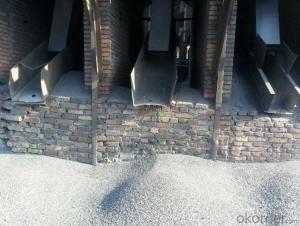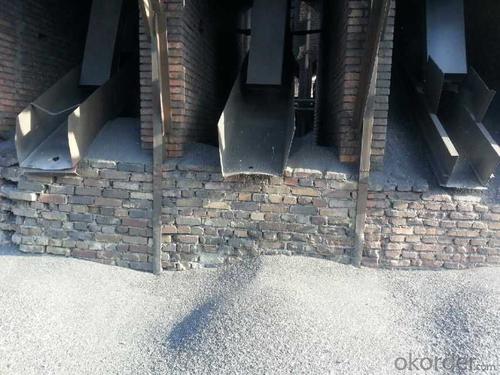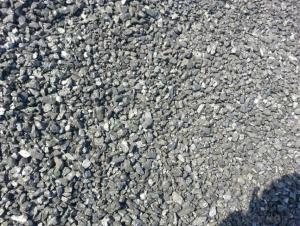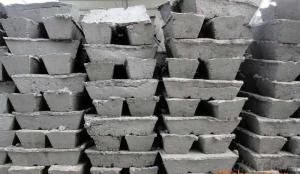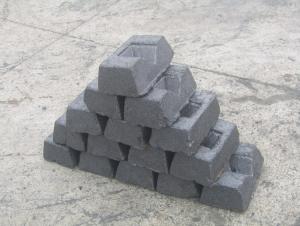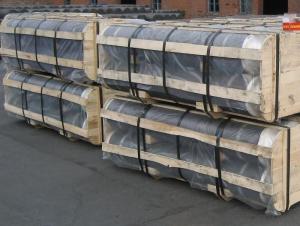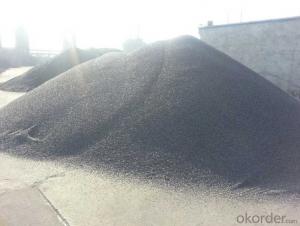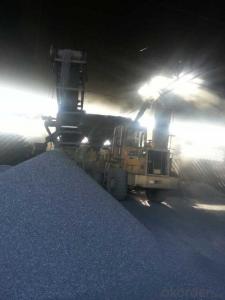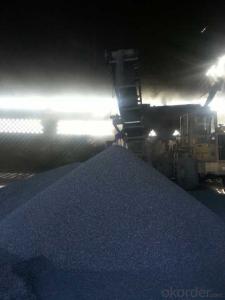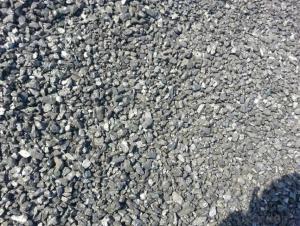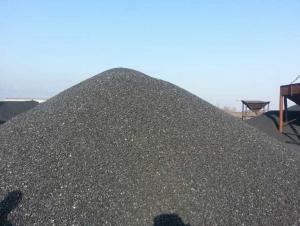Good Quality Injection Carbon With FC 80-95%
- Loading Port:
- Tianjin
- Payment Terms:
- TT OR LC
- Min Order Qty:
- 20 m.t.
- Supply Capability:
- 3000 m.t./month
OKorder Service Pledge
OKorder Financial Service
You Might Also Like
Good Quality Injection Carbon With FC 80-95%
Features of caclined anthracite
1. strong supply capability
2. fast transportation
3. lower and reasonable price for your reference
4.low sulphur, low ash
5.fixed carbon:95% -90%
6..sulphur:lower than 0.3%
Package
In 25KG bags or in MT bags
Product Description
Cardon additives made from well-selected Tai Xi anthracite .Mainly used in steelmaking
in electrical stove, screening water,quality,shipbuilding sandblast removing rust producingcarbon materials.Mainly industry property of it is : instead of traditional pertroleum coal of Carbon Additives,reduce the cost of steelmaking.
Specification
parameter unit gurantee value
F.C.% 95MIN 94MIN 93MIN 92MIN 90MIN
ASH % 4MAX 5MAX6 MAX6.5MAX8.5MAX
V.M.% 1 MAX 1MAX1.0MAX1.5MAX 1.5MAX
SULFUR % 0.3MAX0.3MAX0.3MAX0.35MAX0.35MAX
MOISTURE %0.5MAX0.5MAX0.5MAX0.5MAX0.5MAX
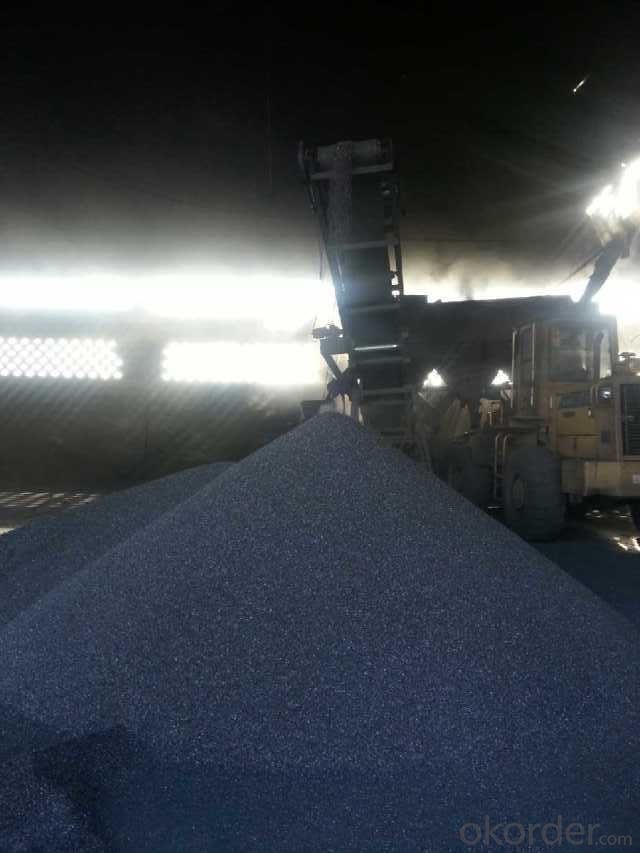
- Q: How is carbon used in the production of filters?
- Carbon is used in the production of filters due to its highly porous nature and ability to adsorb impurities. It acts as a powerful adsorbent, attracting and trapping contaminants such as chemicals, odors, and particles from air or water. This makes carbon an excellent material for removing impurities and improving the quality of filtered products.
- Q: What are the advantages of carbon-based solar cells?
- The advantages of carbon-based solar cells include their low cost and abundance of raw materials, as carbon is a widely available element. They also exhibit high efficiency and can be flexible, lightweight, and transparent, allowing for diverse applications. Additionally, carbon-based solar cells have a low environmental impact and can be easily manufactured using scalable techniques.
- Q: What are the impacts of carbon emissions on the stability of deserts?
- Carbon emissions have significant impacts on the stability of deserts. One of the key consequences is the exacerbation of desertification, which refers to the process of fertile land turning into desert due to various factors, including climate change. Carbon emissions contribute to global warming, leading to higher temperatures and increased evaporation rates, which in turn result in reduced soil moisture and increased aridity in desert regions. This intensifies the process of desertification, causing deserts to expand and become more unstable. Furthermore, carbon emissions contribute to the alteration of precipitation patterns, which directly affects the stability of deserts. As climate change leads to shifts in weather patterns, some areas may experience reduced rainfall, while others may face more frequent and intense droughts. These changes in precipitation can further exacerbate desertification processes and lead to increased desert instability. Another impact of carbon emissions on desert stability is the increased frequency and intensity of dust storms. As global warming leads to drier conditions and reduced vegetation cover, the risk of dust storms becomes higher. These storms can transport vast amounts of fine particulate matter, including dust and sand, over long distances, resulting in a range of negative consequences. Dust storms can damage infrastructure, harm human health, degrade air quality, and further contribute to desertification processes by removing fertile topsoil. Additionally, the impacts of carbon emissions on deserts are not limited to their ecological stability but also have socio-economic implications. Many communities in desert regions rely on agriculture and natural resources for their livelihoods. The destabilization of deserts due to carbon emissions can lead to reduced agricultural productivity, increased food insecurity, and economic hardship for these communities. Moreover, the displacement of people from desert regions due to desertification can lead to increased migration and social instability. In conclusion, carbon emissions have far-reaching impacts on the stability of deserts. They contribute to the intensification of desertification processes, alter precipitation patterns, increase the frequency and intensity of dust storms, and have socio-economic consequences. Addressing carbon emissions through climate change mitigation strategies is crucial to minimize these impacts and ensure the long-term stability of desert ecosystems and the communities that depend on them.
- Q: How does carbon affect the formation of cyclones?
- Carbon dioxide (CO2) and other greenhouse gases, primarily emitted through human activities, contribute to the warming of the Earth's atmosphere. This increase in temperature impacts the formation and intensity of cyclones. Warmer sea surface temperatures provide more heat and moisture, fueling the development and strengthening of cyclones. Additionally, higher levels of carbon dioxide may lead to changes in atmospheric circulation patterns, potentially affecting the location and frequency of cyclone formation.
- Q: Is there any difference between carbon plate and universal board?
- Moreover, due to the characteristics of the rolling process, the mechanical properties of the steel plate vary greatly in the rolling direction and other directions (anisotropy), especially the impact power index is more obvious.In addition, the industry often encountered "cold-rolled carbon structural steel plate", "high-quality carbon structural steel plate" and so on, we should pay attention to distinguish between, do not mix.
- Q: How does carbon impact the stability of savannah ecosystems?
- Carbon plays a crucial role in the stability of savannah ecosystems. It is an essential element for all living organisms and is involved in various ecological processes. Carbon is primarily present in the form of organic matter, which is vital for the growth and development of plants, the primary producers in these ecosystems. In savannahs, carbon impacts stability in multiple ways. Firstly, carbon dioxide (CO2) is a key component of the Earth's atmosphere and plays a significant role in regulating the global climate. Savannas are known for their ability to sequester and store large amounts of carbon in their vegetation and soils. This carbon storage helps mitigate climate change by reducing the amount of CO2 in the atmosphere. Furthermore, carbon is essential for plant growth through photosynthesis. Savanna plants, such as grasses and scattered trees, utilize carbon dioxide from the air, converting it into carbohydrates and other organic compounds. This process not only provides plants with energy but also contributes to the overall productivity of the ecosystem. The stability of savannah ecosystems also depends on the interaction between plants and animals. Carbon-rich vegetation serves as a food source for herbivores, such as zebras and antelopes, which in turn support predators like lions and hyenas. The carbon cycle ensures a continuous flow of energy and nutrients throughout the food web, maintaining the balance and stability of the ecosystem. Moreover, the carbon content in savannah soils influences their fertility and ability to retain moisture. Organic matter, derived from decaying plant material, improves soil structure, nutrient availability, and water holding capacity. This, in turn, supports the growth of vegetation and sustains the diverse array of species found in savannah ecosystems. However, human activities, such as deforestation, agricultural practices, and the burning of fossil fuels, are altering the carbon balance in savannahs. Deforestation removes carbon-rich trees and plants, reducing the overall carbon storage capacity of the ecosystem. Additionally, the release of carbon dioxide from the burning of fossil fuels contributes to the greenhouse effect and climate change, which can disrupt the stability of savannah ecosystems. In conclusion, carbon plays a critical role in maintaining the stability of savannah ecosystems. It influences climate regulation, supports plant growth, provides energy for the food web, and enhances soil fertility. However, human activities that disrupt the carbon balance in these ecosystems can have detrimental effects on their stability and overall health. Therefore, efforts to conserve and restore savannah ecosystems are essential for preserving their carbon storage capacity and ensuring their long-term stability.
- Q: How does carbon affect the pH of water?
- Carbon can affect the pH of water through the process of carbonation. When carbon dioxide (CO2) dissolves in water, it reacts with the water molecules to form carbonic acid (H2CO3). This reaction increases the concentration of hydrogen ions (H+) in the water, resulting in a decrease in pH. Therefore, carbonation lowers the pH of water, making it more acidic. Additionally, carbonic acid can further dissociate into bicarbonate ions (HCO3-) and hydrogen ions (H+), which also contribute to the increase in acidity. It is important to note that the impact of carbonation on pH depends on the concentration of carbon dioxide present in the water.
- Q: How is carbon used in the production of nanotubes?
- Due to its distinctive characteristics and its capacity to establish robust covalent bonds, carbon is widely utilized in the manufacturing of nanotubes. Nanotubes are cylindrical arrangements composed entirely of carbon atoms that are organized in a hexagonal lattice. Two primary methods are employed to produce nanotubes: arc discharge and chemical vapor deposition (CVD). In the arc discharge technique, a high voltage is applied in an inert gas environment, causing a plasma arc of high temperature to form between two graphite electrodes. This arc vaporizes the carbon source material, and as the vaporized carbon atoms cool down, they condense and align themselves into nanotubes. This process enables the controlled creation of multi-walled carbon nanotubes (MWCNTs), which consist of concentric tubes nested within each other. On the contrary, chemical vapor deposition involves the decomposition of carbon-containing gases, such as methane or ethylene, on a catalyst surface at elevated temperatures. The catalyst, typically composed of transition metals like iron, nickel, or cobalt, facilitates the growth of nanotubes by providing active sites for carbon atoms to attach and form tubular structures. Depending on the reaction conditions, the resulting nanotubes can be either single-walled (SWCNTs) or multi-walled. In both methods, carbon serves as an essential building block. Its exceptional carbon-carbon bonding nature enables the creation of sp2 hybridized carbon atoms, resulting in a sturdy and stable lattice structure. This structure imparts nanotubes with outstanding mechanical, electrical, and thermal properties, making them highly sought after in various fields such as electronics, materials science, and medicine. Additionally, carbon's versatility allows for the production of functionalized nanotubes by incorporating other elements or molecules into their structure. This is accomplished through chemical modification of the carbon framework, which permits the attachment of diverse functional groups or nanoparticles. Functionalized nanotubes can exhibit improved properties or be customized for specific applications, further underscoring the significance of carbon in nanotube production. In conclusion, carbon plays a crucial role in the production of nanotubes, owing to its unique properties, ability to form strong covalent bonds, and versatility. It serves as the ideal building block for creating these remarkable structures with a wide range of applications.
- Q: What are the advantages of carbon-based fuel cells?
- There are several advantages of carbon-based fuel cells. Firstly, carbon-based fuel cells, such as those using hydrogen or methanol, have a high energy density, allowing for longer operating times and greater efficiency. Secondly, carbon-based fuel cells are environmentally friendly as they produce fewer emissions compared to traditional fossil fuel combustion. Additionally, carbon-based fuel cells are versatile and can be used in a variety of applications, from powering vehicles to providing electricity for homes and businesses. Finally, carbon-based fuel cells offer a promising alternative to traditional energy sources, reducing our dependence on finite resources and contributing to a more sustainable future.
Send your message to us
Good Quality Injection Carbon With FC 80-95%
- Loading Port:
- Tianjin
- Payment Terms:
- TT OR LC
- Min Order Qty:
- 20 m.t.
- Supply Capability:
- 3000 m.t./month
OKorder Service Pledge
OKorder Financial Service
Similar products
Hot products
Hot Searches
